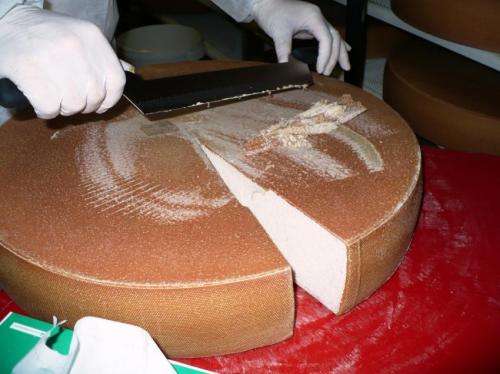Life on cheese: Scientists explore the cheese rind microbiome

Bacteria and moulds are vital to the ripening and aroma of many cheeses. Scientists from the Institute for Milk Hygiene, Milk Technology and Food Science at the University of Veterinary Medicine, Vienna are working to identify the microorganisms that live on the rind of Vorarlberger Bergkäse, an Austrian alpine cheese. Researchers found differences between young and aged cheeses, but also in samples from different cheese cellars. Environment and production techniques also influence cheese flora. The research results were published in the International Journal of Food Microbiology.
The rind is the boundary layer between a cheese and its environment. It hosts a variety of microorganisms that comprise the microbiome: a symbiotic community whose members perform different tasks. Some break down proteins and fats on the rind, for example, creating volatile sulphur and ammonia compounds that are responsible for the intensive odour of some types of cheese.
There are different curing methods for cheese. Some, like Limburger, Tilsiter and Appenzeller, need specific bacteria on their rinds. Others, like Camembert and Brie, develop their aroma with the assistance of moulds.
Vorarlberger Bergkäse - a model cheese
Vorarlberger Bergkäse is a regional speciality. Tons are produced every year, and similar varieties are made in the Tirol Alps and the Bavarian region of Allgäu. "In France, research into the microorganisms found on cheese is very advanced. Yet until now, the microbiome on Vorarlberger Bergkäse and other similar cheeses had hardly been investigated at all", explains study director Stephan Schmitz-Esser.
Collecting cheese in the name of science
Microbiologist Schmitz-Esser and lead author Elisa Schornsteiner worked with colleagues from the Agricultural Chamber of Vorarlberg to gather samples from three different Vorarlberger cheese dairies. Schornsteiner collected 25 to 30 rind samples from cheese wheels at different curing stages from very young to well-aged. Then the scientists ran detailed genetic analyses on the rinds to identify the strains of bacteria and yeast living on them.
"Marine bacteria" with an unknown role discovered on rind
For the first time, these genetic analyses have revealed the entire spectrum of microorganisms that inhabit Vorarlberger Bergkäse. One find interested experts in particular: The Halomonas bacteria, a halophillic microbe probably originating from the sea, was the most common microorganism on the cheese and especially prevalent on young cheese rinds. Since the salt concentration on a cheese rind drops during the ripening process, researchers found older rinds hosted correspondingly fewer Halomonas. The exact role the microorganism plays in the cheese-making process is currently unknown and will be the subject of additional studies. The importance of the yeasts found on the cheese rinds is also still unclear and requires further investigation.
The microbiome's role in cheese making
Microorganisms on cheese not only preserve the final product and make it aromatic and delicious; they are also very important for food safety. Many of the bacteria on the rind prevent the spread of potentially dangerous pathogens by excreting inhibitors against other bacteria, such as listeria.
"Understanding exactly which microorganisms are on the rinds and the role each plays in the complex community is the subject of our research", explains Schmitz-Esser. "This will allow us to help cheese dairies make safe, tasty cheeses".
More information: The article "Cultivation-independent analysis of microbial communities on Austrian raw milk hard cheese rinds" by Elisa Schornsteiner, Evelyne Mann, Othmar Bereuter, Martin Wagner and Stephan Schmitz-Esser was published in the International Journal of Food Microbiology. dx.doi.org/10.1016/j.ijfoodmicro.2014.04.010
Journal information: International Journal of Food Microbiology
Provided by University of Veterinary Medicine -- Vienna


















